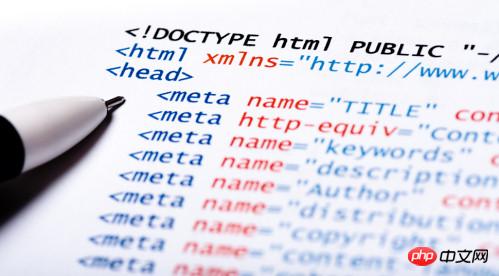HTML tag nesting rules
There are many XHTML tags: p, ul, li, dl, dt, dd, h1~h6, p, a, addressa, span, strong... When we use these tags to build the page structure, we can embed them infinitely. However, nesting also requires certain rules. You cannot allow your own personal habits to be nested randomly. So, what are the nesting rules for html tags?

1. HTML tags include block-level elements (block) and inline elements (inline)
1. Block-level elements
Generally used to build website architecture, layout, and content... It includes the following tags:
address, blockquote, center, dir, p, dl, dt, dd, fieldset, form, h1~ h6, hr, isindex, menu, noframes, noscript, ol, p, pre, table, ul
## 2. Inline elements
Generally used in certain details or parts of website content to "emphasize, distinguish styles, superscripts, subscripts, anchor points", etc. The following tags are all embedded elements:a, abbr, acronym, b, bdo, big, br, cite, code, dfn, em, font, i, img, input, kbd, label, q, s, samp, select, small, span, strike, strong, sub, sup, textarea, tt, u, var
2. Nesting rules of HTML tags
1. Block elements can contain inline elements or certain block elements, but inline elements cannot contain block elements. They can only contain other inline elements:
< h1>
—— Right## —— True
# 2. Block-level elements cannot be placed inside
:
—— Wrong
3. There are several special block-level elements that can only contain inline elements and cannot contain block-level elements. These special tags are:
h1, h2, h3, h4, h5, h6, p, dt
4. li can contain the p tag - this one does not need to be listed separately Yes, but many people on the Internet have some doubts about this, so I will briefly explain it here:
The li and p tags are both containers for loading content. They have equal status and have no distinction in levels (for example: strict hierarchies such as h1 and h2^_^). You must know that the li tag can even be its parent ul or ol. Accommodating, why do some people think that li cannot accommodate a p? Don't think that li is so stingy. Don't think that li is quite thin. In fact, li has a big heart...5. Block-level elements are juxtaposed with block-level elements, and inline elements are juxtaposed with inline elements:
——Yes
##—— Wrong
The above is the detailed content of HTML tag nesting rules. For more information, please follow other related articles on the PHP Chinese website!

Hot AI Tools

Undresser.AI Undress
AI-powered app for creating realistic nude photos

AI Clothes Remover
Online AI tool for removing clothes from photos.

Undress AI Tool
Undress images for free

Clothoff.io
AI clothes remover

Video Face Swap
Swap faces in any video effortlessly with our completely free AI face swap tool!

Hot Article

Hot Tools

Notepad++7.3.1
Easy-to-use and free code editor

SublimeText3 Chinese version
Chinese version, very easy to use

Zend Studio 13.0.1
Powerful PHP integrated development environment

Dreamweaver CS6
Visual web development tools

SublimeText3 Mac version
God-level code editing software (SublimeText3)

Hot Topics
 1386
1386
 52
52
 What is the purpose of the <progress> element?
Mar 21, 2025 pm 12:34 PM
What is the purpose of the <progress> element?
Mar 21, 2025 pm 12:34 PM
The article discusses the HTML <progress> element, its purpose, styling, and differences from the <meter> element. The main focus is on using <progress> for task completion and <meter> for stati
 Is HTML easy to learn for beginners?
Apr 07, 2025 am 12:11 AM
Is HTML easy to learn for beginners?
Apr 07, 2025 am 12:11 AM
HTML is suitable for beginners because it is simple and easy to learn and can quickly see results. 1) The learning curve of HTML is smooth and easy to get started. 2) Just master the basic tags to start creating web pages. 3) High flexibility and can be used in combination with CSS and JavaScript. 4) Rich learning resources and modern tools support the learning process.
 What is the purpose of the <datalist> element?
Mar 21, 2025 pm 12:33 PM
What is the purpose of the <datalist> element?
Mar 21, 2025 pm 12:33 PM
The article discusses the HTML <datalist> element, which enhances forms by providing autocomplete suggestions, improving user experience and reducing errors.Character count: 159
 What is the viewport meta tag? Why is it important for responsive design?
Mar 20, 2025 pm 05:56 PM
What is the viewport meta tag? Why is it important for responsive design?
Mar 20, 2025 pm 05:56 PM
The article discusses the viewport meta tag, essential for responsive web design on mobile devices. It explains how proper use ensures optimal content scaling and user interaction, while misuse can lead to design and accessibility issues.
 What is the purpose of the <iframe> tag? What are the security considerations when using it?
Mar 20, 2025 pm 06:05 PM
What is the purpose of the <iframe> tag? What are the security considerations when using it?
Mar 20, 2025 pm 06:05 PM
The article discusses the <iframe> tag's purpose in embedding external content into webpages, its common uses, security risks, and alternatives like object tags and APIs.
 The Roles of HTML, CSS, and JavaScript: Core Responsibilities
Apr 08, 2025 pm 07:05 PM
The Roles of HTML, CSS, and JavaScript: Core Responsibilities
Apr 08, 2025 pm 07:05 PM
HTML defines the web structure, CSS is responsible for style and layout, and JavaScript gives dynamic interaction. The three perform their duties in web development and jointly build a colorful website.
 What is the purpose of the <meter> element?
Mar 21, 2025 pm 12:35 PM
What is the purpose of the <meter> element?
Mar 21, 2025 pm 12:35 PM
The article discusses the HTML <meter> element, used for displaying scalar or fractional values within a range, and its common applications in web development. It differentiates <meter> from <progress> and ex
 Understanding HTML, CSS, and JavaScript: A Beginner's Guide
Apr 12, 2025 am 12:02 AM
Understanding HTML, CSS, and JavaScript: A Beginner's Guide
Apr 12, 2025 am 12:02 AM
WebdevelopmentreliesonHTML,CSS,andJavaScript:1)HTMLstructurescontent,2)CSSstylesit,and3)JavaScriptaddsinteractivity,formingthebasisofmodernwebexperiences.




